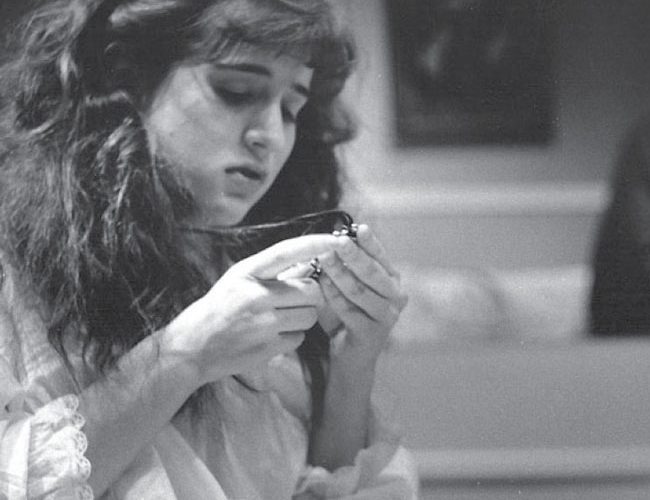
Rosary Hartel O’Neill is a regaled playwright and scholar who is currently juggling several different plays being performed in venues across the globe. One of her most promising works, Degas in New Orleans, focuses on the real-life experiences of the renowned French painter Edgar Degas who travelled to New Orleans in the years after the Civil War in attempts to help his finically struggling American family. Rosary, who was raised in New Orleans and is bilingual, hopes that the play will be performed in both English and French. In September of 2016, she traveled to Paris where she discussed the future possibilities for the work and her newest play, Beckett at Greystones Bay, which follows a period in the life of famed writer Samuel Beckett. Below, writer Meagan Meehan chats with Rosary about these experiences.
Meagan Meehan: What were these experiences in Paris like?
Rosary Hartel O’Neill: Fantastic. Everywhere you walk you are surrounded by so much beauty. I lived in the 5th arrondissement right next to the Sorbonne and just a half a block away was the gorgeous huge Pantheon and just four blocks away was Luxenbourg Gardens with its gigantic statue of Cupid and Psyche reminding us always of the importance of love and beauty and the huge gift that art is for the heart. I was recharged and began re-loving my role as a writer, a passer thru of stories and of experiences.
We live so briefly and it’s marvelous to see and hear and be surrounded by Churches and Parks and the Seine and museums and fountains all that remind us of beauty and of our little part in the legacy of life if only to pass our experiences on. I wondered as I left if Degas hadn’t felt something similar when he came back from New Orleans to Paris. New Orleans is the only Southern city that was preserved perfectly after the Civil War because the soldiers didn’t get that far South to destroy it. But the French Quarter which is where Degas roamed, is only 14 square blocks and the commercial area where he painted “A Cotton Office” is not much bigger. Surely, when he returned back to Paris the sight of these enormous buildings gracing the sky must have once against astonished him, the splendid city hall, Hotel de Ville, the Notre Dame Cathedral stretching its peaks up into the sky, and then the Arche de Triomphe, Tuileries Gardens. It goes on and on. When you are surrounded by beauty and majesty you want to create up to a higher level. And when you capture the pain as Degas did in his portraits of Nurses, invalids, the colors and the pain about illness and death has a depth that goes down even further.
Megan: What are the future possibilities for Degas in New Orleans?
Rosary: Well, just a skip and a jump behind the Irish Cultural Center in the Latin Quarter where I had the residency is the great Sorbonne University – the oldest European university dating back to the 16th century – and so the graduate students in American studies came over the huge courtyard of the Irish Cultural center to learn about my play and in April of 2017, graduate students in Joseph Danan’s masters class will put on a staged reading in French of Degas in New Orleans in the Salle de Richelieu of the Sorbonne. That show will hopefully also be performed in the Courtyard of the Irish Cultural Center. And the scandalous story of Degas’ visit to New Orleans will be experience in Europe for the first time.
Megan: What was the food like in Paris? Would some of the dishes be what Degas and his family might have eaten back in the 1800s?
Rosary: The food was buttery, spicy, and fresh, like escargots, seafood salad, duck confit. I particularly loved how Parisians buy the baguette of bread right before supper and carry it with a napkin because the loaf is still warm. I’m sure the bread was wondrous back in 1872 too and, of course the restaurants in New Orleans today like Antoine’s and Galatoire’s — which were around back then — still serve that hot warm bread. One of the scenes in my play Degas In New Orleans takes place on Christmas Even when Degas’ family is drinking warm eggnog with the froth on top and Edgar confronts his cousin Telle with his love for her. Another scene (Edgar’s arrival scene) Edgar enjoys chicory coffee prepared for him, a drink locals still relish in the city today. New Orleanians’ love for drink and food rests on their Latin roots: appreciation of companionship and leisure. In Degas In New Orleans, Degas and his relatives sit on the gallery and imbibe lemonade while struggling to confront the quicksand life around them. Bullets are fired on the street and they hurry inside. No longer can Edgar pretend that New Orleans where he had hoped to live is like the marvelous outdoor promenades of Paris where people sit imbibe and people watch.
Megan: Paris is a hub of the arts, including fashion. How did you approach the fashion angle of your historic Degas play?
Rosary: Women in Paris dress in understated elegance. Sheer cashmere sweaters, with a string of pearls, soft leather clutch purses, and the finest equestrian boots. In Paris, people dress for others, to make an entrance and an exit, because they live outside their small homes on the glamorous wide streets, which are resplendent with light even at night. I imagine it was difficult for Edgar’s relatives who were living in poverty in Reconstruction New Orleans to greet him in dingy clothes, old shoes, and worn ribbons rather than new finery, which the event would have mandated. So much of Degas’ time in New Orleans was spent indoors because of the fierce heat and harsh weather conditions, something he rarely experienced in Paris and the danger in the streets from the occupation by Northern soldiers.
Megan: How did the weather in Paris differ from New Orleans? For instance, might Degas have been surprised by how warm the American South was? If so, do you think that affected his work?
Rosary: The heat irritated Edgar’s eyes and kept him trapped inside with his cousins – one of whom he fell in love with. The heat motivated the moody close-ups he painted which led to his impressionistic paintings in France. One has the sense in Paris with its open streets and high skies that foul weather can easily pass through. In New Orleans, Edgar experienced the violence of weather: hurricanes, floods, mosquito-infested days. The weather warred inside his soul and created a texture of loss below even the sunniest of paintings.
Megan: Transportation has made it much easier to travel. Today, you can hop a plane to Paris in a few hours. What was the process of traveling like for Degas? How long would his trip have taken?
Rosary: Well, traveling to Paris from New York today seemed short (seven hours) until I got to the airport and had to wait five hours on my feet to go through security – some passport problem somewhere for someone stalled the lot of us arriving in Charles de Gaule. I was reminded of the hostile time Degas visited New Orleans during Reconstruction 1872, how much paperwork you needed to travel then, how difficult it was for foreigners and blacks to move about when all were suspect. The idea of war waging in the wings heightens drama. I particularly wanted to
go to Paris during this post-Iran terror time to show the French how much I love and cherish them and Paris. I suppose Degas had the same anticipation and unease traveling to New Orleans to help his cousins. Degas was also meeting his brothers – who were trying to save his Uncle’s Cotton business and going bankrupt there – and his brother’s wife whom Edgar was still in love with. So much courage it took for Edgar to go to Louisiana with a small pocket of money and a big pocket of love.
Megan: Do you have any new plays, or parts to Degas, planned for the future?
Rosary: Well, not for Degas, but in April my new play Beckett at Greystones Bay will be performed at Columbia University Paris’ Reid Hall as part of their Global outreach series. Barret O’Brien who staged the two act play at the Oregon Shakespeare Festival’s Midnight Series will star. Beckett left Ireland to claim Paris as his home and wrote all of his plays there. A street in Paris is now named for him, and all Frenchman claim Beckett as un fils de la France (a son of France).
Megan: Do you hope to return to Paris soon?
Rosary: I will be in Paris in March and April of 2017 for the staging of Degas in New Orleans and Beckett at Greystones Bay and to work with Philippe Adrien at the Theatre de la Tempete on the latest staging techniques he has used when mounting Beckett.
Megan: Is there anything else you would like to mention?
Rosary: Well, while the excitement of Paris is its old and beautiful and rich, the excitement of New York – returning to the place that is now my home – is its new and exciting and daring and unbridled so there’s a kind of energy in the creation here that is magical. One expands into history by daring in the present. I think that Degas and Beckett would both love NYC and spend a lot of time in the parks and museums here and look for cafes for rest stops where they could reflect and talk. Travel helps me take rest stops in my home to look and see differently to appreciate where I come from and to reach out globally to all my brothers and sisters in the arts who try to work each day to the strengths of their abilities and use what their countries give them to create the finest art. Hopefully as an artist I will keep growing and learning and Paris is a touchstone in this. Only death would keep me from Paris!
Feature photo from Degas in New Orleans.

Newly Available for Licensing – October 2025 (US)

Newly Available for Licensing – October 2025 (UK)

